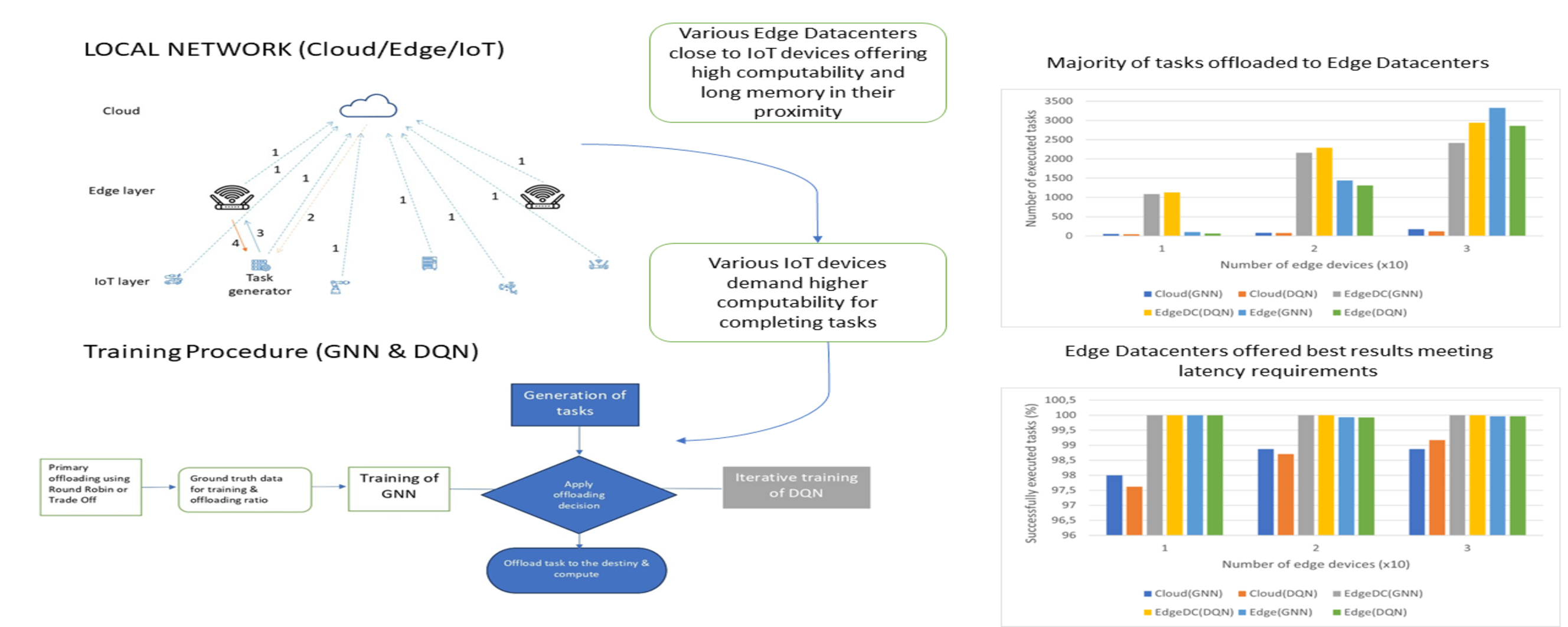 Open Access
Open Access
ARTICLE
Task Offloading in Edge Computing Using GNNs and DQN
1 Department of Applied Mathematics, University of the Basque Country UPV/EHU, Eibar, 20600, Spain
2 TECNALIA, Basque Research and Technology Alliance (BRTA), San Sebastian, 20009, Spain
* Corresponding Author: Jose David Nunez-Gonzalez. Email:
Computer Modeling in Engineering & Sciences 2024, 139(3), 2649-2671. https://doi.org/10.32604/cmes.2024.045912
Received 11 September 2023; Accepted 04 December 2023; Issue published 11 March 2024
Abstract
In a network environment composed of different types of computing centers that can be divided into different layers (clod, edge layer, and others), the interconnection between them offers the possibility of peer-to-peer task offloading. For many resource-constrained devices, the computation of many types of tasks is not feasible because they cannot support such computations as they do not have enough available memory and processing capacity. In this scenario, it is worth considering transferring these tasks to resource-rich platforms, such as Edge Data Centers or remote cloud servers. For different reasons, it is more exciting and appropriate to download various tasks to specific download destinations depending on the properties and state of the environment and the nature of the functions. At the same time, establishing an optimal offloading policy, which ensures that all tasks are executed within the required latency and avoids excessive workload on specific computing centers is not easy. This study presents two alternatives to solve the offloading decision paradigm by introducing two well-known algorithms, Graph Neural Networks (GNN) and Deep Q-Network (DQN). It applies the alternatives on a well-known Edge Computing simulator called PureEdgeSim and compares them with the two default methods, Trade-Off and Round Robin. Experiments showed that variants offer a slight improvement in task success rate and workload distribution. In terms of energy efficiency, they provided similar results. Finally, the success rates of different computing centers are tested, and the lack of capacity of remote cloud servers to respond to applications in real-time is demonstrated. These novel ways of finding a download strategy in a local networking environment are unique as they emulate the state and structure of the environment innovatively, considering the quality of its connections and constant updates. The download score defined in this research is a crucial feature for determining the quality of a download path in the GNN training process and has not previously been proposed. Simultaneously, the suitability of Reinforcement Learning (RL) techniques is demonstrated due to the dynamism of the network environment, considering all the key factors that affect the decision to offload a given task, including the actual state of all devices.Graphic Abstract

Keywords
Cite This Article
 Copyright © 2024 The Author(s). Published by Tech Science Press.
Copyright © 2024 The Author(s). Published by Tech Science Press.This work is licensed under a Creative Commons Attribution 4.0 International License , which permits unrestricted use, distribution, and reproduction in any medium, provided the original work is properly cited.


 Submit a Paper
Submit a Paper Propose a Special lssue
Propose a Special lssue View Full Text
View Full Text Download PDF
Download PDF Downloads
Downloads
 Citation Tools
Citation Tools